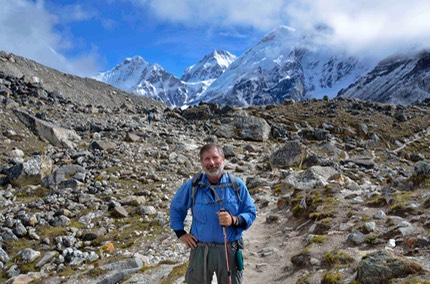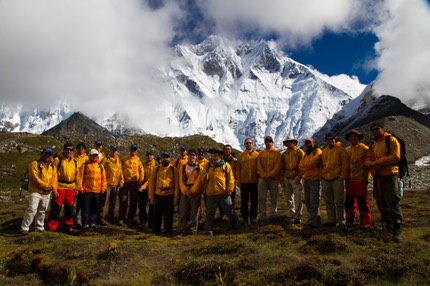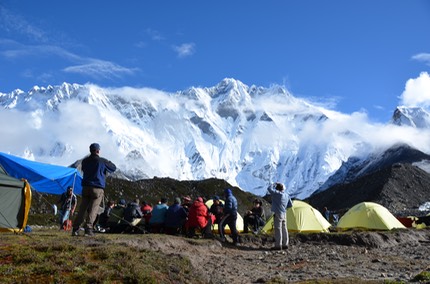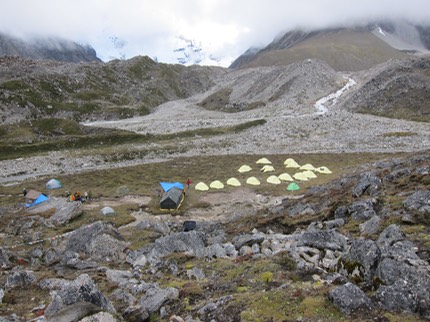
Near Gorak Shep
Researchers from the Center for Research in Water Resources (CRWR) at The University of Texas at Austin engaged in a program of developing water management tools for use in basin of the Nepalese Himalayas. The research is focused on developing adaptation strategies for basin stakeholders to deal with climate change impacts on water resources and security in these glacier dominated basins.
This research has been supported by the US Agency for International Development (USAID), the US National Science Foundation, the Fulbright Program and greatly facilitated by The Mountain Institute. Some of the results of this research are available at the links listed below.
High Mountains Adaptation Partnership
The aim of the High Mountains Adaptation Partnership is to increase awareness for the critical importance of high mountain glacial watersheds globally in the context of climate change, highland-lowland interactions, and ecosystem services. This will be achieved through the development of innovative high mountain tools, approaches, and the establishment of a unique high mountain Community of Practice. The Program will create enabling conditions necessary for local communities, governments, and stakeholders living in and/or dependant on high glacial watersheds to (a) build resilience to the impacts of climate change, (b) advance scientific knowledge of high mountain systems and processes, and (c) increase global awareness and support for the critical importance of high mountain glacial environments.
Click here for more information
FIELDWORK AT IMJA GLACIAL LAKE IN NEPAL, May-June 2018
In May-June, 2018, the HiMAP team returned to Nepal to do fieldwork at Imja Lake.
FIELDWORK AT IMJA GLACIAL LAKE IN NEPAL, June 2016
In June 2016, the HiMAP team will return to Nepal to do fieldwork at Imja Lake.
FIELDWORK AT IMJA AND LUMDING GLACIAL LAKES IN NEPAL, November 2015
In November 2015, the HiMAP team returned to Nepal to do fieldwork at Imja and Lumding Glacial Lakes and the Khumbu Glacier.
POST-EARTHQUAKE ASSESSMENT OF GLACIAL LAKES IN NEPAL, June-July 2015
In June and July 2015, the HiMAP team returned to Nepal to do a field reconnaissance of the post-earthquake damage to dangerous glacial lakes: Imja, Thso Rolpa and Thulagi.
Imja Khola, November 2014
In November 2014, the University of Texas at Austin will return to Nepal to complete the field reconnaissance of dangerous Imja Lake in Nepal. This time we will download data and retreive our instrumentation and monitoring equipment form the Imja and Lhotse-Shar glaciers: automatic weather station (thanks to Attila Novaselac and Rich Corst at UT Austin); ablation stakes; debris temperature sensors on the glacier, and a time-lapse camera to film the calving oof the glacier front. We will present results of our work to the Khumbu Alpine Conservation Council in Dingboche.
Imja Khola, May 2014
In May 2014, the University of Texas at Austin returned to Nepal to continue the field reconnaissance of dangerous Imja Lake in Nepal. This time we continued our instrumentation and monitoring of the Imja and Lhotse-Shar glaciers. We installed an automatic weather station (thanks to Attila Novaselac and Rich Corst at UT Austin), put in ablation and stakes debris temperature sensors at 20 sites on the glacier, and installed a time-lapse camera to film the calving of the glacier front. We again presented results or our work to the Khumbu Alpine Conservation Council in Dingboche (see the video).
Imja Khola, September 2013
In September 2013, the University of Texas at Austin returned to Nepal to continue the field reconnaissance of dangerous Imja Lake in Nepal. This time we focused on the evolution (melt rate) of the Imja and Lhotse-Shar glaciers and their impact on the evolution of Imja Lake. We conducted GPR surveys and measured the temperature in the debris cover of the glaciers. We also presented results or our work to the Khumbu Alpine Conservation Council in Dingboche. We were joined by Ulyana Horodyskyj from the University of Colorado who is studying the nearby Ngozumpa glacier.
Imja Khola, September 2012
In September 2012, TMI and the University of Texas at Austin returned to Nepal to continue the field reconnaissance of dangerous Imja Lake in Nepal to complete surveys to characterize the risk posed by this lake and to present results to the Khumbu Alpine Conservation Council in Dingboche.
Hinku and Imja Kholas, May 2012
In May 2012, TMI and the University of Texas at Austin returned to Nepal in May 2012 to complete the field reconnaissance of dangerous lakes in Nepal (Tama Pokhari and Dudh Pokhari in the Hinku Valley and Thulagi near Anapurna) and to Imja Lake to conduct surveys to characterize the risk posed by these glacial lakes.
Imja Lake Expedition, September 2011
In September 2011, TMI and the University of Texas at Austin organized the “2011 Andean-Asian Glacial Lake Expedition” to the Imja lake (focus of our proposal’s work site) which was made up of physical and social scientists from the Andes, Hindu Kush-Himalaya, Central Asia, Japan, North America and Europe (representatives came from 15 different countries). Throughout the three week field expedition, specialists exchanged experiences for the control and management of dangerous glacial lakes in consultation with local people. In addition to two separate meetings with concerned villagers held on 10 and 19 September in Dingboche village, local people accompanied the scientists to Imja lake on 13 September to study the lake. This expedition and the following workshops were funded by USAID, the US State Department, and UNDP with generous contributions from sponsors like the North Face.
The unique on-site field expedition was followed by a four-day workshop between 25-28 September 2011 in Kathmandu, hosted by TMI and the International Centre for Integrated Mountain Development (ICIMOD). There, expedition members were joined by additional physical and social scientists from the Hindu Kush-Himalayan region for an innovative series of presentations and exchange of experiences, followed by a “Writers Workshop” where priority recommendations for next steps and action were captured.

The 2011 Imja Glacial Lake Expedition below the towering wall of Lhotse Shar (8386 m). As many of the larger glaciers have melted in the Hindu Kush-Himalaya (HKH) and Andes as a result of climate change, hundreds of new glacier lakes, holding millions of cubic meters of water, have been created. Usually contained by dams of loose boulders and soil, these lakes present a risk of glacial lake outburst floods (GLOFs). GLOFs unleash stored lake water often causing enormous devastation downstream that can include high death tolls as well as the destruction of valuable farmland and costly infrastructure (e.g., hydroelectric facilities, roads, and bridges).
(Photo by Daniel Byers)

Imja Lake in 2011. During the 2011 Expedition, local people from the KACC pointed out a disturbing number of potential GLOF “triggers” that have gone unnoticed by scientists studying the region, including: new crevasses in the debris-covered terminal moraine, indicating the ice core nature of the moraine that may be undergoing rapid melting processes; the growth, merging, and expansion of small meltwater ponds that could turn much of the remaining terminal moraine into a lake within the near future; water seepage at the exterior base of the terminal moraine that may indicate further instability; and, of course, the huge volume (35 million m3) of water contained within the lake itself.
(Photo: Katalyn Voss)

Imja Lake basecamp with Lhotse in the background.
(Photo by Daene McKinney)

Imja Lake basecamp and lake outlet.
(Photo by Daene McKinney)
For more information, contact Dr. Daene McKinney at: daene@aol.com.
